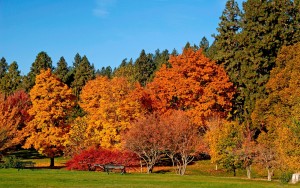Certainly, everyone loves the scenic aesthetics of “Fall” or “Autumn” due to the multitude of colors in the trees. Vibrant reds, oranges, yellows, even some purple; I remember as a kid, it was one of my favorite things to look forward to throughout the cycles of the seasons. Though everyone expects the leaves to change colors naturally, I don’t think it is common knowledge (at least not for me) as to why they do so. Understandably, there is some kind of specific environmental science explanation, therefore, I decided to conduct some research.
According to Environmental Information Series, the summer and spring months are meant for and necessary to the tree’s survival. The leaves serve as little manufacturers of food for the tree’s growth. This “food-making process” takes place within the leaves’ cells which contain chlorophyll. Chlorophyll, by the way, is what gives leaves their bright green color.
Not only do leaves have substances of green pigment but yellow and orange pigments as well. However, most months of the year the bright orange and yellow colors are masked by the vast amounts of green pigments.
In the fall, as there is less and less sunlight, the leaves, in turn, are receiving less sunlight. The trees will rest, and live off the food they stored during the summer. They begin to shut down their food-making factories (leaves) and the green chlorophyll slowly starts to disappear from the leaves. “The chlorophyll breaks down, the green color disappears, and the yellow to orange colors become visible and give the leaves part of their fall splendor.” (EIS)
Certain trees may change to specific colors. For example, the oak tree typically transforms its leaves to more brown-based colors.
Also as a kid, I vividly remember this certain group of trees in my neighborhood that would be especially bright and vibrant. My mom and I always loved to admire those certain trees. I wondered why those trees were exceptionally brighter than the others during their seasonal transformation. It turns out that temperature, light, and water supply all have an influence on the degree and the duration of fall color. The type of tree also has an impact as well.
“Low temperatures above freezing will favor anthocyanin formation producing bright reds in maples. However, early frost will weaken the brilliant red color. Rainy and/or overcast days tend to increase the intensity of fall colors.” (EIS)
Trees strangely have a mind of their own in terms of how they prepare themselves for the changing of seasons. Especially fall going into winter. This is all thanks to the process of photosynthesis.
It’s interesting to know how the processes of nature and the environment produce such visually intriguing things for the earth’s inhabitants. I’ll always enjoy the color-changing trees a little bit more now knowing the extensive and enlightening process that takes place.
Sources:
http://www.esf.edu/pubprog/brochure/leaves/leaves.htm
http://www.sciencemadesimple.com/leaves.html
http://chemistry.about.com/od/howthingsworkfaqs/f/fallleafcolor.htm



Fall is by far my favorite time of year, simply due to the fact that the leaves change to such pretty colors. I’ve always wondered why they did this, so i’m glad you did a post on the topic! I knew that Chlorophyll was what gave leaves their green color, but I had no idea that leaves also contained yellow and orange pigments as well. I also always wondered why certain trees turned different colors, so I thought it was interesting that the type of tree, temperature, light, and water supply all have an influence on it. Since there are many factors that go into the color and a lot can change in a year, it makes me wonder if the same tree could have different colored leaves every fall. It seems like that is a definite possibility,
It is nice to see what makes fall the most beautiful season of the year. This article provides really good information on why leaves turn to other colors and I am surprised that the temperature can affect what color trees present in fall. However, what I am wondering what makes brown or yellow pigment stays longer than green pigment, and if green pigment is in chlorophyll, what are yellow pigment and brown pigment in? Why do they exist in leaves?